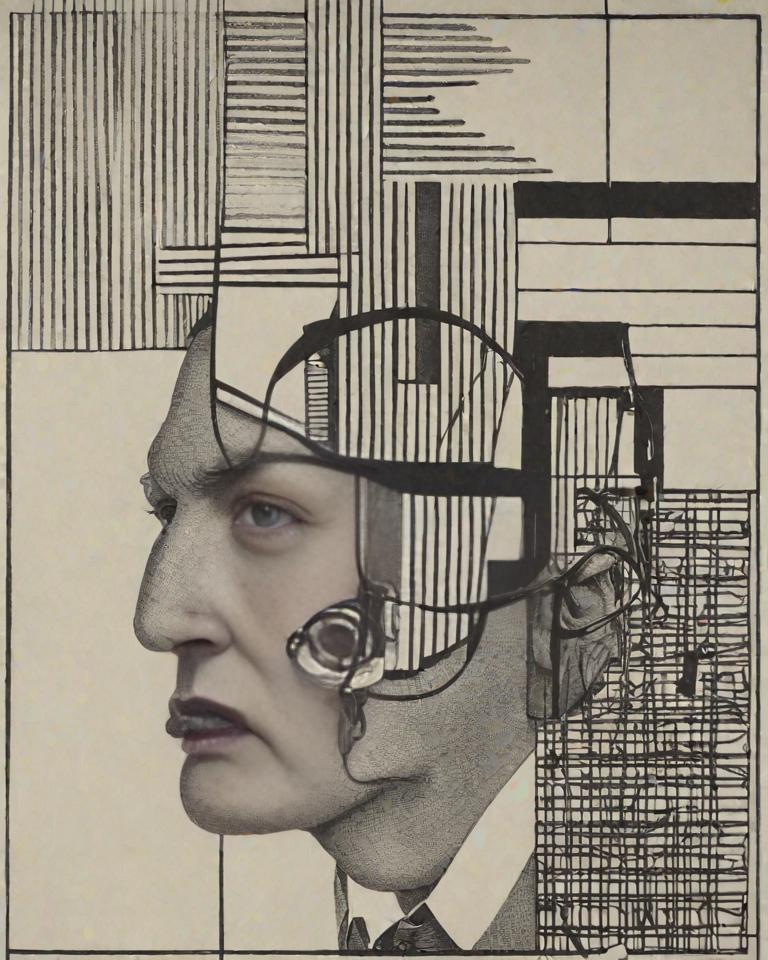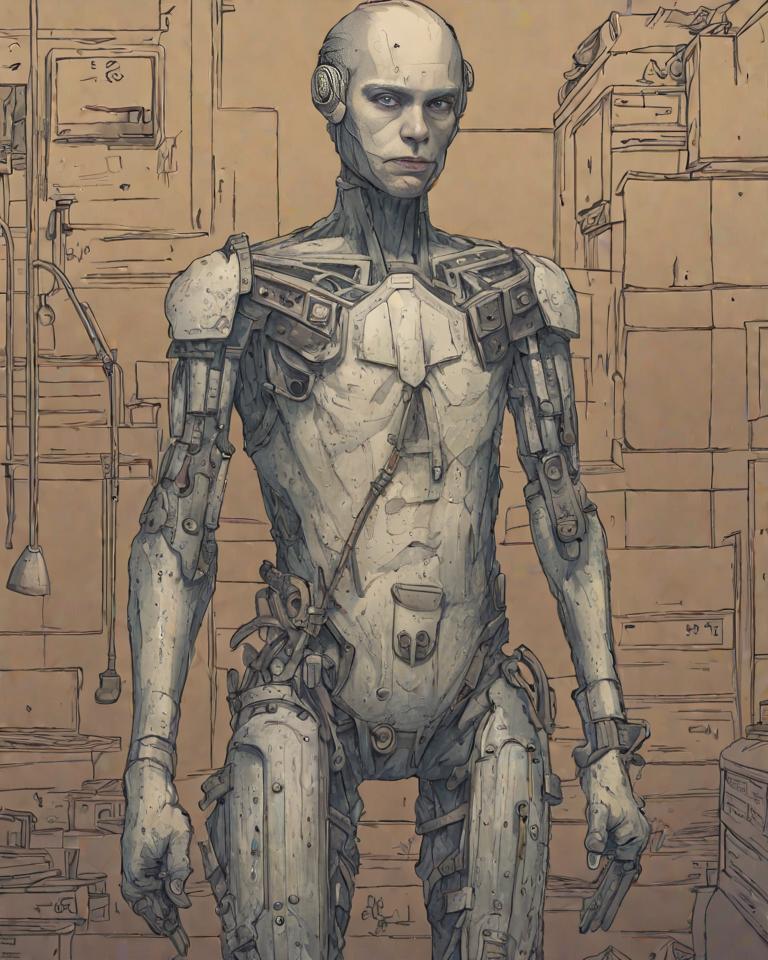
prompt: a postmodern Übermensch.

prompt: a transhumanist tech executive.

prompt: a posthuman.
I recently read How We Became Posthuman: Virtual Bodies in Cybernetics, Literature, and Informatics by N. Katherine Hayles, a book about the disembodiment of information as we move further into virtuality. Although it serves as a balanced investigation of the cultural idea of the cyborg, including the hope and the horror, she ultimately presents becoming posthuman in a liberating light. This idea of liberation is one of the driving factors behind transhumanist thought. Freedom from age, freedom from illness, and even freedom from death. Achieving these goals with the advancement of technology is not a new ambition, as the fundamental ideas behind transhumanism are said to have stemmed from Daedalus or Science and the Future, written by geneticist J.B.S. Haldane in 1924. However, I want to discuss a sort of postmodern Übermensch. A tech executive who sees the natural, not engineered brain as an evolutionary failing, an investor seeking enlightenment, or a veteran turned physicist trying to invent immortality. All three individuals possess an almost religious fervour, a perfectionist ethical imperative to eliminate disability and disorders, that fails to interrogate what the “enhancement” of our species truly means.
The Übermensch is a concept proposed by philosopher Friedrich Nietzsche, which in English could be called a superior human, in which he posits a departure from Christian morals, instead proposing the development of humanist ideals. The German prefix über can mean over or beyond and sometimes has connotations of transcendence. Despite Nietzsche being staunchly antisemitism and antinationalist, Hitler and the Nazi regime frequently used a racialised version of the term Übermensch when referring to their ideal master race. This fascist reading also gives way to the idea of Untermenschen (literally under-men or sub-men). In my research on transhumanist ideals, I couldn’t help but wonder about this dichotomy and how it would apply to a posthuman future. Transhumanist advocates see the brain as a computer, and the body as a machine. Within this narrative, humans could fix, upgrade, and improve our limited bodies with ease. What would equality mean to us in a world where there are people who are cybernetically “superior”, and how would it fare for the people left behind? Will diverse bodies be accepted or will ableist discrimination take on a new form? This genetic divide is explored in the 1999 film Gattaca, an alternate science-fiction reality in which the protagonist has been conceived outside of the eugenicist genetics program. He seeks to overcome the genetic discrimination of his society to achieve his dream of going to space. This film is often cited by transhumanist critics who voice concerns about a dystopia in which our current socioeconomic problems - such as accessible healthcare, the wealth gap, and the climate crisis - went unaddressed before the normalised adoption of human enhancement technologies.
In the contemporary quest for directed evolution, few of the major players, if any, seem to be burdened with any form of techno-progressivism or alternative technologies. This is despite the transhumanist tenet of the betterment of all life. In the 2011 film Limitless, the protagonist Eddie receives a mystery pill that unlocks 100% of his brain capabilities. Instead of solving any of the world’s issues, he becomes incredibly rich playing the stock market, gets mixed up with a Russian criminal whose one dimensional character simply serves as “the bad guy”, kills him, and succesfully runs for office. He ultimately ends up happy and has an endless supply of the pill for the rest of his life. The criminal Gennady hunts Eddie down looking for more pills throughout the movie. Withdrawal symptoms can be debilitating and usually result in death. He is also addicted before he is killed, but is not given the same sympathy or ways to better his life by the writers as the protagonist is. Gennady is a Russian with a heavy accent, a politicially salient choice for a US film in the post Cold War era, and a criminal, in a country historically known for extreme punitiveness. He is also a distorted Übermensch, but the wrong kind. It is revealed by the end of the film that many of the world’s rich and powerful are all taking the drug, which is what allows them to be super-intelligent and super-successful. The implication here is that if you are given the tools to rise above your present conditions and play the game of capitalism well, you will be rewarded with success and happiness in your posthuman body. I think this cinematic representation serves as a cautionary tale, a manifestation of my concerns about the potential consequences of prioritizing certain individual’s enhancements without addressing systemic issues, a theme I continue to come across in the transhumanist movement's current trajectory.

prompt: a postmodern Übermensch.

prompt: a transhumanist tech executive.

prompt: a posthuman.
The above images are Runway ML outputs I received. I chose to only create 1 output each and to keep the prompts as simple as possible so as to not cloud the outcomes with my perspectives. The fact that all three prompts rendered masculine, white/pale figures aligns with my critique of transhumanism as potentially perpetuating exclusivity and reinforcing existing power structures. It suggests an implicit bias or a reflection of prevailing societal norms within the field of technology and of course subsequent transhumanist discourse. It reflects the current demographics of the technology industry where representation is skewed, raising questions about whose perspectives, values, and aspirations are being prioritized in the pursuit of posthuman ideals. These generated outputs from Runway serve as a microcosm of the broader societal challenges that the transhumanist movement must grapple with to fulfill its stated goals of a more inclusive and equitable posthuman future.
Amidst the allure of science-fiction dreams, the influx of millions in grant money, and the fascination with futuristic technologies like Neuralink and the embodied reality of the metaverse, a critical element of transhumanism seems to be lost: activism. Moreover, the vast amounts of money flowing into the various projects may inadvertently prioritize profit-driven endeavors over those with the potential to alleviate social issues. The popular research avenues commonly pursued by organizations like the Foresight Nanotech Institute, focusing on areas such as space exploration, health extension (anti-aging), and immortality, are unquestionably intriguing; however, they prompt inquiries regarding the distribution of resources. For a movement that professes to be envisioning a new world, transhumanism often falls short in terms of imagination when it comes to reshaping socioeconomic structures. There is a pressing need for transhumanists to engage in critical discussions about the ethical implications of their pursuits, actively advocating for systemic changes, and integrating anti-capitalist perspectives into their discourse. Currently, it feels like the Western ideology of continual progress is being transposed onto minds and bodies. Without a more grounded and socially conscious approach, the grand promises of transhumanism are overshadowed by the very inequalities it should be aiming to transcend.